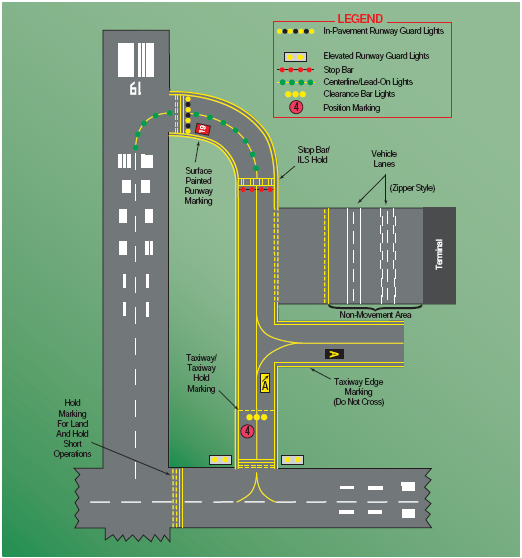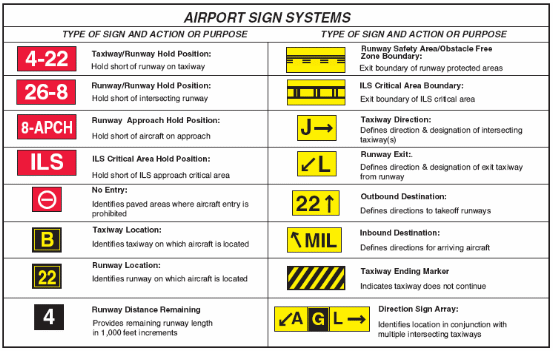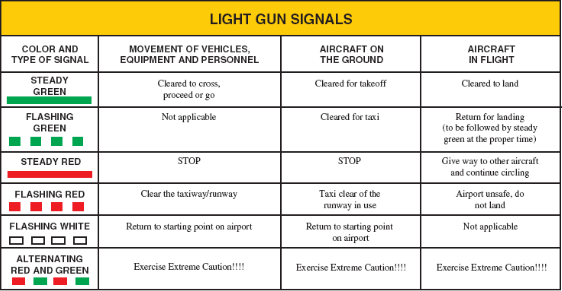Lesson Overview
The student should develop knowledge of the elements related to taxiing an airplane as required in the ACS/PTS.
References : Airplane Flying Handbook (FAA-H-8083-3C, page(s) 2-14,10-6)
| Key Elements |
|
| Elements |
|
| Schedule |
|
| Equipment |
|
| IP Actions |
|
| SP Actions |
|
| Completion Standards |
The student can safely maintain positive control of the airplane with the proper crosswind corrections. The student understands the elements related to safely and effectively taxiing. |
Instructor Notes
| Attention |
Taxiing is one of the basic skills required anywhere you fly. At some airports with many taxiways it can be intimidating and therefore is very important to understand how to safely and efficiently taxi an airplane. |
| Overview |
Review Objectives and Elements/Key ideas |
| What |
Taxiing is the controlled movement of the airplane under its own power while on the ground. |
| Why |
Since the airplane is moved by its own power between the parking area and runway, the pilot must thoroughly understand and be proficient in taxi procedures. |
Lesson Details
To taxi the airplane from point A to point B on the airport surface a pilot must know how to interpret the signs and markings used on the airport grounds. The most ubiquitous taxiway marking is the continuous yellow centerline stripe. Stay centered on the stripe to stay safe. At certain airports there are also taxiway edge markings. A continuous yellow line means that the shoulder is not intended for use by aircraft, and a dashed line means an aircraft may use at least a portion of that pavement.
Holding short lines denote a location that the aircraft must not cross until it is cleared to do so. These lines are four yellow lines stacked together, two solid and two dashed. When approaching the hold short lines from the dashed side the aircraft may cross without clearance, but when approaching from the solid side the aircraft must have a clearance before progressing.

Along with the surface markings signs help direct the pilot to the desired location on the airport surface. The following image show a number of the common signs found on the airport surface. This includes runway designation signs, ILS critical area indications, taxiway locations, pointers indicating taxiway directions, taxiway ending signs, as well as others.

Once the pilot knows how to find their way around the airport, they must know how to control the aircraft while taxiing on the airport surface. Steering is generally accomplished with the rudder pedals and brakes (there are some exceptions, but this is the most common arrangement for small aircraft).
To turn apply rudder in the direction of the desired turn, and use power/brake to control the taxi speed. It can be the case that brakes are needed to facilitate a turn, and this is done by adding brake on the "inside" of the turn. Rudder is held until just short of the point where the turn is to stop, then pressure is released to maintain the taxiway centerline.
Brakes are used to both assist in turns, moderate the taxi speed of the aircraft, and stop the aircraft. Do not ride the brakes as this can unnecessarily wear and heat the brakes, and in extreme cases this could heat them enough to start a brake fire. Moderate taxi speed with throttle as much as possible. Speed is controlled first with throttle, and second with brake. It should be noted that you may need to use some extra power to start the aircraft moving, but that power should be pulled back to a more moderate level once the aircraft breaks loose from the parking spot.
The centerline should be maintained during taxiing, and the student should work with the instructor to determine the sight picture that results in a position on the centerline. Adjust the sight picture as needed for the individual pilot and aircraft.
|
Common Errors
|
At an airport with a tower, permission must be obtained before taxiing the aircraft into a movement area when the tower is in operation. Together, runways and taxiways are known as the movement areas of the airfield. All other areas (ramp, etc.) are considered non-movement areas. A clearance also must be obtained prior to crossing any runway. ATC will issue an explicit clearance for each runway crossing. Any runway means literally any runway, whether active, inactive, open, closed, etc.
When assigning taxi instructions ATC will specify :
-
The runway or point to taxi to
-
Taxi instructions
-
Hold short instructions, or runway crossing clearances if the route will cross a runway
-
This does not authorize the aircraft to enter or cross the assigned departure runway at any point
-
Taxi instructions will not include implicit instructions to cross a runway. All runway crossings will require explicit clearances.
-
Always read back the taxi instructions to the controller. Before taxiing ensure that they make sense, and that every step is understood. If there is any doubt have the instructions clarified, or request a progressive taxi. Always have an airport diagram on hand to help identify the route issued.
At the start of taxiing there are a few quick checks that should be performed. As the aircraft starts to move out of the parking spot perform a quick check of the brakes to insure they are functioning properly. If not, retard the power and shut down the aircraft immediately.
Verify instruments by confirming that the attitude indicator shows no more than about 5° of either pitch or bank. The turn and slip indicator should indicate the movement in the direction of turns, and that the inclinometer is full of fluid. The magnetic compass and heading indicator should be moving toward known headings and that the magnetic compass shows no cracks, fluid leaks, or bubbles.
During taxi operations the wind should be factored into the positioning of the aircraft controls. Taxiing downwind will generally take a little less power after the ground roll has started. To avoid overheating the brakes keep engine power at a minimum and only apply them occasionally.

Taxiing with a quartering headwind ailerons should be turned into the headwind and the elevator is held neutral. This helps avoid having the wind lift the upwind wing. The upwind aileron is UP reducing the effect of the lifting action, and the downwind aileron will be DOWN adding a small amount of lift/drag on that wing to also help keep the upwind wing down.
Taxiing with a quartering tailwind requires different controls positions. The way many remember positioning is that the ailerons are positioned to "dive with the wind" and the elevator is positioned DOWN. These corrections help minimize weathervaning and provide easier steering.
|
Common Errors
|
It is critical to maintain situational awareness of the environment and the location and movement of other aircraft and vehicles. Visually scan the area constantly looking for hazards, and the pilot should spend a minimum amount of time with their "head in the cockpit". Any checklists should be completed only when the aircraft is not in motion.
While taxiing also monitor the appropriate frequency, and use transmissions from other aircraft or ATC to help maintain situational awareness. During taxiing apply all the normal aircraft right-of-way rules, and don’t become a hazard by inattention.
Taxi slowly, and when yellow taxiway stripes are provided they should be observed. Slow before turns, as high speed turns put excessive load on the gear and can risk an upset or ground loop.
When taxiing, maintain a sterile cockpit to avoid distractions. There should be no checklists being run, conversations, phone calls, texting, or other distractions which would detract from a safe taxi operation.
|
Common Errors
|
Always have a taxi diagram if available. Read back all taxi instructions, hold instructions, and do so using proper phraseology. Review NOTAMs for the airport prior to taxi (looking for taxiway closures, construction, etc.) and be familiar with airport markings and signs. If in doubt, request a progressive taxi.
While taxiing use proper position and taxi lights, and when landing clear the runway in a timely manner. At night there often is an aircraft light which is considered most useful for taxiing, and this is often referred to as the "taxi light". In addition, it is often considered a good practice to operate the aircraft anti-collision light while taxiing, just to increase visibility.
|
Common Errors
|
In the event of a radio malfunction it may be necessary to resort to the use of light gun signals. If possible prior agreement with the tower for use of light gun signals should be made, and there must be a clear understanding on the part of the pilot as to the meaning of the various signals.

Common Errors
-
Improper use of brakes
-
Improper positioning of flight controls for various wind conditions
-
Hazards of taxiing too fast
-
Failure to comply with airport/taxiway surface marking, signals, and ATC clearances or instructions
-
Hazards of becoming distracted while taxiing
-
Hazards associated with failing to adhere to sterile cockpit procedures
Conclusion
Requirements for safe taxiing include positive control of the aircraft, the ability to recognize potential hazards in time to avoid them, and the ability to stop or turn where and when desired without undue reliance on the brakes. Also, be aware of other traffic and its movement, write down and read back all clearances, and maintain the proper crosswind correction.
ACS Requirements
To determine that the applicant:
-
Exhibits instructional knowledge of the elements of landplane taxiing by describing:
-
Proper brake check and correct use of brakes.
-
Compliance with airport/taxiway surface marking, signals, and ATC clearances or instructions.
-
How to control direction and speed.
-
Flight control positioning for various wind conditions.
-
Procedures used to avoid other aircraft and hazards.
-
Runway incursion avoidance procedures.
-
Procedures for eliminating pilot distractions.
-
Use of taxi chart during taxi.
-
Airport, taxiway, and runway position situational awareness.
-
Additional taxiing operations concerns at a non-towered airport.
-
-
Exhibits instructional knowledge of common errors related to landplane taxiing by describing:
-
Improper use of brakes.
-
Improper positioning of the flight controls for various wind conditions.
-
Hazards of taxiing too fast.
-
Hazards associated with failure to comply with airport/taxiway surface marking, signals, and ATC clearances or instructions.
-
Hazards of becoming distracted while taxiing.
-
Hazards associated with failing to adhere to sterile cockpit procedures.
-
-
Demonstrates and simultaneously explains landplane taxiing from an instructional standpoint.
-
Analyzes and corrects simulated common errors related to landplane taxiing